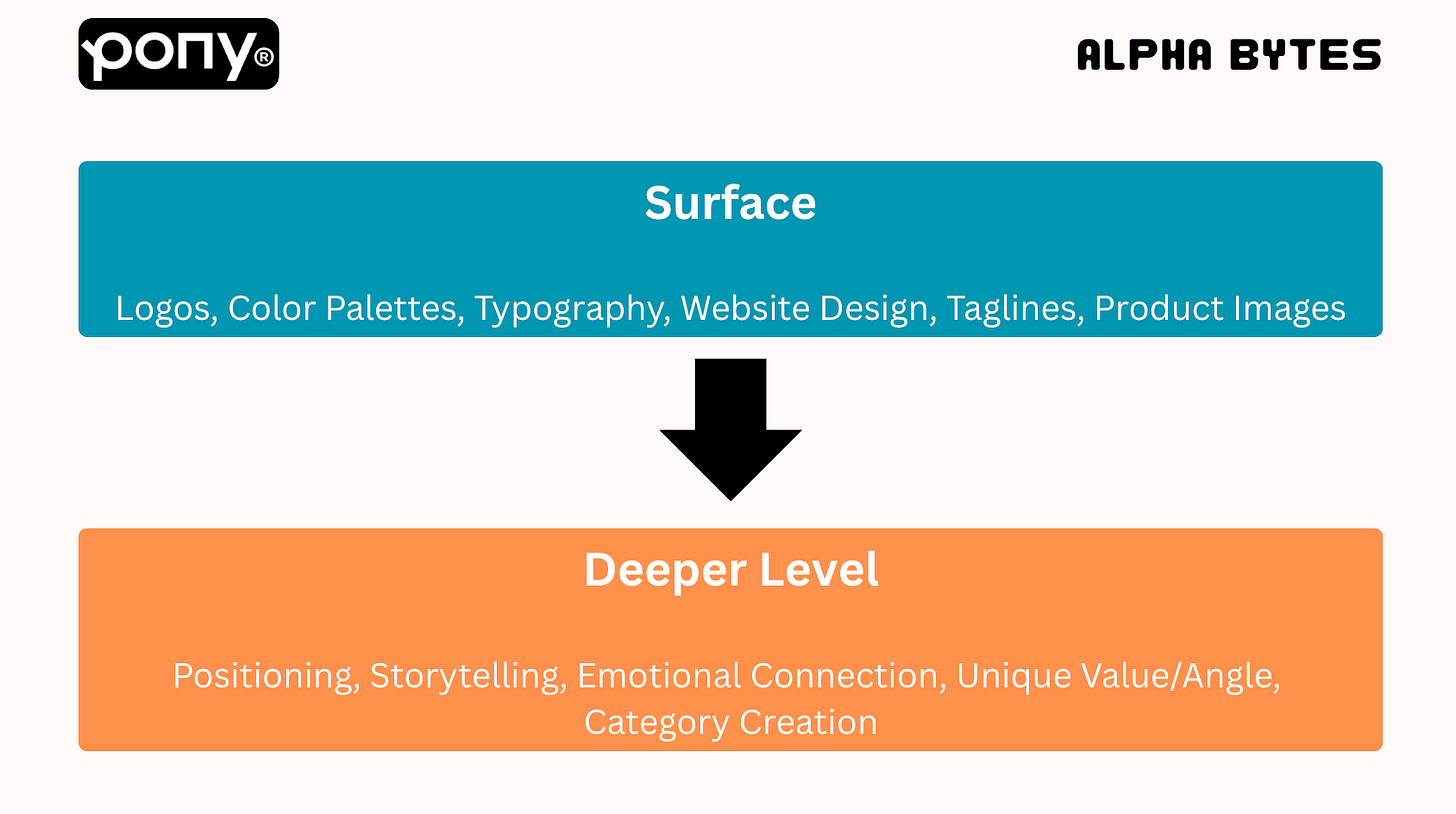Welcome to this edition of our Tactical Field Guide series. This is where we go down the rabbit hole on tactical advice to help you become a better builder, leader, and thinker. We also release a weekly newsletter (The Weekly Signal) showcasing the latest curated signals across technology and innovation. Thanks for reading.
Dear Readers:
If you’re a founder, operator, or builder, you already know the pressure to “get your brand right” is intense. Everyone tells you branding is essential, but no one really explains how to do it in a way that actually moves the needle for your business. The general advice is “hire an agency”, “create a killer logo”, or even “find your unique story”. But when you follow the usual playbook, you often end up with something that looks great on paper but doesn’t really help you win real customers or stand out from all the noise.
The real problem is that most early-stage founders approach branding as ticking off a checklist. They spend money on design, messaging, and PR before their product is ready or before they’ve figured out what truly makes them different. They imitate other successful startups, hoping some of that magic will rub off. But the results are usually disappointing, with lots of noise, little traction, and a brand that feels generic or disconnected from the real work you’re doing.
Most founders usually pour hours and dollars into branding projects, but then realize that their efforts didn’t stick or resonate. And it turns out they’re building their brand from the outside in, not the inside out.
So hopefully this field guide should help.
I wanted to cut through the confusion and share some practical and honest thoughts from Stef Ivanov, someone who’s helped dozens of startups build brands that actually work. His core belief is that having clarity, consistency, and even the courage to stand for something, even if it means ignoring the latest trends or saying no to easy shortcuts, will take your brand much further.
Stef Ivanov is the Founder and Creative Director at Pony Studio, a branding agency that helps tech companies build iconic brands and digital products. Based in London, Stef has over a decade of experience as a designer and front-end developer, working with countless startups and scaleups, including those backed by Y Combinator, Techstars, and Seedcamp. He’s known for his hands-on approach to branding, design, and strategy
If you want to learn more about effective brand building, you can check out Stef’s Branding Studio, Pony.studio, to see how you could work with him and his team. You can also read Stef’s Substack F*NORM.
Today, we’ll go over:
The most common branding mistake early-stage founders make
What “brand” really means in the age of AI-generated design
When founders should start thinking about their brand, and first steps to take
The difference between real branding and just having a good-looking logo or website
Examples of early-stage companies with strong brands and the role of culture
How a founder’s own story shapes the brand early on
The highest-leverage branding investments when resources are tight
How founders can discover and define their brand voice
Simple ways to build a sense of belonging and community around a new brand
How to tell if your brand is resonating or just “noise”
How a brand should evolve as the company grows, and warning signs it’s time
How non-marketers can avoid the “sameness trap” with templates and AI tools for a shift
One piece of advice for founders starting from zero
Let’s dive in.
Q: You’ve worked with startups from Y Combinator to Techstars and have seen it all when it comes to branding. What’s the most common branding mistake you see early-stage founders make?
Stef: The biggest mistake I see is confusing brand depth with brand expense. Early founders (pre-seed to Seed) often think hiring a big agency, rolling out merch, chasing press, or crafting messaging for five personas will solve their real problem, when the product itself isn’t ready yet.
At this stage, branding should be brutally simple: a clear promise, a sharp look, and relentless consistency. You have to prove people want what you’re selling. The rest can wait.
Later on, around Series A and beyond, the trap is treating the brand as a one-off event. Founders spend big on a rebrand and think the job’s done. But branding is a long game—it takes years of consistency before people notice and remember you. Most startups are playing short-term games, not building long-term memory.
Across the board, too many teams focus on making things “pretty” or just imitating brands they admire. That’s safe, but it rarely pays off. The real question is: what makes us radically different? Where’s the gap in our industry that we can own? And do we have the guts to stand there? That’s how you build a brand people actually talk about.
Here are some key red flags to look out for:
You’re spending more on swag than on solving support tickets.
You’ve got five buyer personas but zero real traction.
You’re rebranding every year because you’re bored, not because the market needs it.
You care more about looking like your favorite brand than becoming the brand in your space.
Q: It’s fair to say that AI is all around us. It’s so easy to access and use. In a world where AI can generate logos and websites in minutes, what does “brand” actually mean for a young company?
Stef: AI has leveled the playing field. Soon, every brand will have cool visuals, slick sites, clever copy, all generated in minutes. That’s not differentiation anymore.
Now, brand is about what’s felt, not just what’s seen. It’s how you’re positioned in people’s minds, the story you tell, the category you create, the unique angle you own. For example, if you’re building a time-tracking app, AI can make it look beautiful. But are you just another time tracker? Or do you reframe it as a platform for employee well-being or unlocking peak performance?
Brand is moving from what’s visible to what’s felt. Ironically, that makes it even more valuable. This is why it’s so important to build a brand on both the surface and deeper levels.
Q: When you think about the stage of a company, how early should founders start thinking about their brand, and what are the first steps they should take?
Stef: Honestly? Day one. But not in the way most people think.
You don’t need a full brand system or fancy design out of the gate; you just need to look real enough that people trust you. Early on, brand is about positioning—getting clear on your edge, your angle, why you exist, and what makes you worth noticing. The visuals can evolve, but your point of view is what matters most.
And don’t underestimate your own presence. Social doesn’t care about company updates anymore; founders have to be ambassadors. People buy from people.
Practical Tips:
DO: Document what you’re learning, share your take on your industry, and tell real stories from the trenches.
DON’T: just post generic “inspo quotes” or press fluff—people tune that out fast.
A strong founder brand is often the fastest way to build trust and attention. It’s your unfair advantage, especially early on. Just look at people like Adam Robinson from Retention.com, Neil Patel, or Noah Kagan — they’re really good examples of how showing up as yourself builds massive leverage.
If I had to give founders a quick brand to-do list for day one, it’d be:
That’s it. Do that consistently, and you’re way ahead of most.
Q: What’s the difference between real branding and just having a good-looking logo or website?
Stef: A good-looking logo or website just means you look polished. That’s surface-level—necessary, but it stops there.
Real branding is about how people feel about you, the story they tell themselves, and the space you occupy in their minds. I call this being incomparable. It’s when you’re so clear and distinct that people can’t just line you up with competitors. They can’t swap you out, because there’s nothing quite like you.
Most brands operate at different strategic levels: some compete just on features and price (“One of Many”), some redefine the game and become the obvious choice in their category (“Category Leader”), and a rare few carve out a unique space entirely (“Category of One”). But no matter where you are, you can add what we call the Uncomparable Emotional Layer—that’s what makes people connect with you like they do with people: vividly, emotionally, even irrationally.
Think about how we relate to people: you might trust someone, be inspired by them, or even feel a bit annoyed—but either way, they’re alive in your mind. Great brands work the same way. Patagonia is a perfect example: it’s not just outdoor clothing, it stands for something deeper. You feel something specific, whether that’s admiration or skepticism.
If you can get people to think about your company like they think about a person—with real emotion, good or bad—you’re on the right track.
Q: Can you share a real-world example of an early-stage company that built a strong brand from the start? What did they do differently? How does culture come into the equation?
Stef: Notion is a great example. From the start, they didn’t just build a tool; they built a culture around simplicity, craftsmanship, and empowering creative thinkers. Their brand wasn’t just clean design or friendly tone—it was the whole vibe, down to how they talked about “tools for thought.”
That early culture shaped everything—their community, the playful way people shared templates, and how fans felt proud to be part of it. They didn’t just sell software; they made you feel like you were joining a movement. A movement about freedom, independence, and control. It was a belief system from day one, and it was authentic. That’s brand done right.
Another is Fluent.xyz, one of our crypto portfolio companies at Pony. They’re the first Blended Execution Network, combining EVM, SVM, and Wasm into one chain so you can build 10x apps with a 10x toolkit. We doubled down on their name and the big idea of “blended.” The community loved it.
We made them the stars, featured them boldly on the site, and helped give birth to the Blended Builders Club, which were a group of crypto builders making things the world has never seen before. It turned into a genuine movement, not just another crypto project. They recently raised $7M, and you can see how people rallied behind the vision.
Below is an example from Fluent on how the community comes together to build apps using their platform.
That’s what happens when you go beyond features and build around a clear, authentic culture.
Q: What role does the founder’s own story play in shaping the brand, especially early on?
Stef: A lot. The founder’s story is usually the raw material for the brand, especially early on.
When we work with companies, we kick off with a long half-day workshop where our main goal isn’t logos or taglines, but it’s understanding the people behind it. Everyone has something unique; we just need to find it and not be scared to share it.
Often, the actual product is still evolving, and we may not know the exact solution yet, but we have to know what we stand for. That’s what keeps things anchored.
The real problem is when founders aren’t open. They want to look perfect, not vulnerable. That’s risky, because then you might start building a brand that’s inauthentic from the very beginning, and sooner or later it goes off track and becomes a mess.
Q: When resources are tight, what branding investments give the most leverage?
Stef: For me, the priority is:
Strategy—knowing exactly what you stand for and how you’re different.
Name—it’s often your most powerful, portable asset.
Outstanding visuals—a look that truly sets you apart.
But underneath all these, decent design is a must. It’s the bare minimum to be taken seriously.
Think of it like a salesperson where they don’t need to show up in a designer suit, but if they’re dirty, stinky, or rude, you wouldn’t buy anything from them. Your design is the same: it’s the face people meet first, and it needs to be at least decent and inviting just to start the conversation.
Q: How do you recommend founders discover and define their brand voice?
Stef: You just have to put in the hours. It takes time and effort—trying things, seeing what clicks, figuring out what feels forced versus what feels natural. It’s a process of experimenting, refining, and noticing what actually resonates with people.
The shortcut is working with people who’ve done it before. They can save you months, even years, by helping you avoid obvious mistakes and zero in on your real voice faster. But there’s no escaping that the work as your brand voice is discovered by doing and seeing what works.
Q: What are some simple ways to build a sense of belonging and community around a new brand?
Stef: There’s no hack; people are smart, they see right through it.
Building a community starts with authenticity and standing for something that actually matters to people. Not playing it safe. Too many brands try to look perfect, say all the right things, and end up sounding like everyone else. That’s mediocre by definition.
You’ve got to be willing to stand for something real, even if it means going against the crowd, your own industry, or attracting critics. That’s what draws people in and makes them feel like they belong, because you’re not afraid to be clear about who you are and what you believe.
Q: How can founders tell if their brand is actually resonating—or if it’s just “noise”?
Stef: That’s the million-dollar question. If things are going well, you’ll see it fast—people talking, buying, sharing your story. But how do you know when to keep pushing if you aren’t seeing that yet?
Focus on your first 20–30 favorite customers. Go deep, listen obsessively, and build around them. That’s how cult brands start. Stay close, and you’ll learn exactly what matters and what’s just noise. Start small, go deep, and if you’re onto something real, that’s what naturally grows.
Signs You’re Resonating:
Customers refer others without being asked.
Your story spreads when you’re not in the room.
People repeat your messaging back to you, unprompted.
They’re willing to pay a premium or wait longer, just to work with you.
If you see even small hints of that, you’re resonating. If not, stay close, keep refining, and keep asking why.
Q: How should a brand evolve as the company grows, and what are the warning signs it’s time for a shift?
Stef: The hardest part of growing is that more people mean more opinions—and that usually means more chaos. What started as a clear, sharp brand can easily turn into a Frankenstein of half-baked ideas.
Warning Signs:
You’re telling ten watered-down stories instead of one clear one, and your message has become fragmented, inconsistent, or vague.
The brand you built five years ago doesn’t fit who you’ve become, and your products, customers, and team have evolved, but your brand hasn’t kept up.
You’re seeing confusion inside the company, and teams aren’t aligned, priorities clash, and it’s harder to rally people around a shared mission.
Sales cycles are getting longer, or customers just don’t “get it” anymore—the market is unclear on why they should choose you.
If your brand doesn’t evolve, it starts to slip, slowly at first, then all at once.
Q: For builders who don’t have a background in branding/marketing, how can they avoid the “sameness trap” when using templates and AI tools?
Stef: That’s on you—you can’t buy it.
Templates and AI tools are great for execution. They’ll help you move faster and look polished, but they’ll never figure out your real strategy or what makes you different. If you feed them the same safe ideas as everyone else, you’ll get the same generic outputs, just faster.
You can work with a branding agency to help uncover it, but you’ve got to be real. If you’re not brutally honest about who you are, what you stand for, and where you want to go, no agency can save you.
That’s how you avoid the sameness trap—by staying authentic and building something long-term. Otherwise, you’ll just end up with a brand that looks good for six months and disappears.
Q: If you could give one piece of advice to a founder starting from zero, what would it be?
Stef: You don’t need to know how yet, but you must know why.
Why you, why this, why now?
And be brutally honest. If it’s purely for profit, that’s fine. Just own it. Clarity on your real motivation sets the trajectory for your company and your brand. Without it, you’ll drift, and so will everything you build.
🙋🏻♂️ Survey
To build the best newsletter for you all, I’d love to get some feedback, both positive and negative. If you have some time, please fill out the following survey.
📖 Other Reading
If you liked this, here are a few more popular posts you can read:
🙏🏼 Connect with Me
Are you new to the newsletter? Subscribe Here
Check out my YouTube channel (and subscribe!)
If you’re a founder, apply here (Metagrove Ventures) for startup funding or contact me directly at barry@metagrove.vc
If you think this could be helpful and informative to others, please share it :)
Finally, if you’re a founder or operator who wants to share your insights on product and company building with the next generation of founders, reach out directly to barry@metagrove.vc
Thanks for reading.
Barry.
















